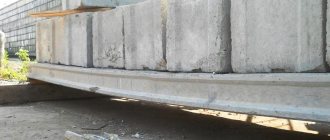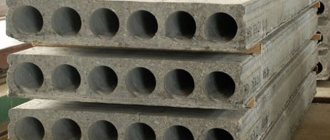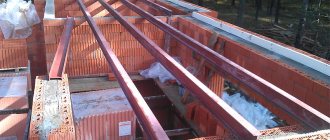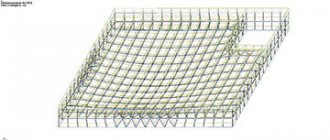They are located longitudinally. The scope of application of such slabs is industrial and civil low-rise and high-rise construction.
The building can be erected from any building material - reinforced concrete panels, brick, wall blocks - gas silicate, foam concrete, aerated concrete, the main thing is to correctly calculate the loads on the floor slabs.
What does the concept mean?
The load on a concrete hollow-core floor slab is the main operational parameter that determines the load-bearing capacity of the product and reflects how many kg of weight a square meter can withstand. m of surface. Reflects the totality of all types of loads that the slab can withstand while performing its functions.
The permissible load on a hollow-core floor slab is one of the main parameters for choosing this product when designing a building. The strength of the structure and the duration of its operation until the need for major repairs arises depend on the accuracy of the calculation.
Step 5. Select the reinforcement section
Failure in floor slabs occurs when the reinforcement reaches its tensile or yield strength. Those. almost everything depends on her. The second point is that if the strength of concrete decreases by 2 times, then the load-bearing capacity of the slab reinforcement decreases from 90 to 82%. Therefore, let’s trust the formulas:
Reinforcement occurs by tying reinforcement from welded mesh. Your main task is to calculate the percentage of reinforcement of the transverse profile with longitudinal reinforcement bars.
As you have probably noticed more than once, its most common types of sections are geometric shapes: the shape of a circle, rectangle, trapezoid. And the calculation of the cross-sectional area itself occurs at two opposite angles, i.e. diagonally. In addition, keep in mind that additional reinforcement also gives a certain strength to the floor slab:
If you calculate reinforcement along a contour, then you must select a certain area and calculate it sequentially. Further, it is easier to calculate the section on the object itself if you take a limited closed object, such as a rectangle, circle or ellipse, and carry out the calculation in two stages: using the formation of an external and internal contour.
For example, if you are calculating the reinforcement of a rectangular monolithic floor in the shape of a rectangle, then you need to mark the first point at the vertex of one of the corners, then mark the second and calculate the entire area.
According to SNiP 2.03.01-84 “Concrete and reinforced concrete structures”, the tensile strength resistance to A400 reinforcement is Rs=3600 kgf/cm², or 355 MPa, but for class B20 concrete the value is Rb=117kgf/cm² or 11.5 MPa:
According to our calculations, to reinforce 1 linear meter you will need 5 rods with a cross-section of 14 mm and a cell of 200 mm. Then the cross-sectional area of the reinforcement will be 7.69 cm². To ensure reliability regarding deflection, the height of the slab is increased to 130-140 mm, then the cross-section of the reinforcement is 4-5 rods of 16 mm each.
So, knowing such parameters as the required grade of concrete, the type and cross-section of reinforcement that is needed for the floor slab, you can be confident in its reliability and quality.
Types of permissible load on structures
The design of any ceiling includes three parts:
- The upper one - with flooring, screeds and insulation (when there is another living space on the floor above).
- The lower one - with ceiling decoration and hanging elements (when housing is also located on the floor below).
- Structural – a load-bearing base on which all the elements of a given part of the structure are mounted (which is the floor slab).
The floor and ceiling with decoration and furniture and interior items located on them, including suspended ceilings, decorative partitions, additional plumbing, children's swings, sports equipment, etc., which are possible in the apartment, provide a constant static load on the floor slab.
Temporary (dynamic) load is understood as that which occurs when people and pets move along the floor structure. At the same time, the calculations even take into account, for example, that all members of the family who will live in a given room may turn out to be obese people, and they will choose as a pet not some light hamster, but large lynx or deer, moving rapidly, almost constantly on the move.
The location of point and distributed loads is taken into account separately. An example of a point one is a suspended punching bag weighing 220 kg, a distributed one is a suspended ceiling system, in the frame of which hangers for the panel are located at a certain distance from each other, attached to the floor slab.
There are nuances in the calculations of point and distributed loads - it is necessary to take into account the functional purpose of the room. Thus, when installing a bathtub with a volume of 520 liters, which, when filled with water, will create a distributed load (due to the area it occupies), the point load from its legs is also calculated separately.
Thus, loads can be permanent - when the entire service life is affected by overlying structures, engineering equipment, communications, etc., and temporary - in three positions:
- Moving living objects indoors, adding new household items and rearranging them.
- Seasonal and weather factors - precipitation (accumulation of rainwater and snow on the roof, eaves and balconies), strong wind.
- Anticipated emergency situations, for example, a collision of a heavy vehicle with a part of a structure or a tower crane falling onto the wall if another construction site is being built nearby, and other similar cases.
In accordance with the coefficients specified in the construction documentation, a standard 6 m hollow core slab (for example, PK 60-15-8), without taking into account its own weight, can withstand the following loads:
- Spot: 1040 kg/m2.
- Distributed: 960 kg/m2.
- Constant: 880 kg/m2.
- Temporary: 1040 kg/m2.
- Limits:
- Minimum: 400 kg/m2.
- Maximum: 1040 kg/m2.
Load on a floor slab in an old panel house
When determining how much weight a floor slab can withstand in an apartment of an old house, a number of factors should be taken into account:
- load capacity of walls;
- condition of building structures;
- integrity of the reinforcement.
When placing heavy furniture and bathtubs of increased volume in old buildings, it is necessary to calculate what maximum force the slabs and walls of the building can withstand. Use the services of specialists. They will perform calculations and determine the magnitude of the maximum permissible and permanent forces. Professionally performed calculations will help you avoid problematic situations.
Standards and requirements
Contained in state and industry documentation that defines the requirements for hollow-core concrete products intended for the construction of floors (SNiP, GOST, etc.).
According to SP 20.13330.2016 “Loads and impacts” (updated edition of SNiP 2.01.07-85) - during construction and restoration construction and installation work, the type of building and its purpose should be taken into account, calculating loads of different types:
- Regulatory - according to clause 8.2.2, a standard partition must withstand a weight of at least 50 kg/m2.
- Calculated - for determination, the reliability coefficients from clause 8.2.2 are used.
- Temporary - for those objects where regular movement of people and animals is planned, frequent rearrangement of furniture and equipment of the premises with additional equipment and household items are expected. Uniformly distributed loads (standards) are specified in clause 8.3 - for example, 150 kg/m2 is provided for residential premises.
Calculator for calculating the amount of concrete for pouring a floor in a garage
Probably all car owners dream of having a durable and reliable garage for their car. And if a lucky opportunity arises to build it, then many try, in order to save money, to carry out all or most of the work associated with it on their own. Whatever garage is built, it must have a durable, wear-resistant floor. In most cases, this can be solved by pouring a concrete base with or without further finishing at your discretion.
Calculator for calculating the amount of concrete for pouring a floor in a garage
The floor in the garage will definitely experience considerable mechanical loads, both static and dynamic, and in addition to this, it very often suffers the negative impact of temperature changes, high humidity, spilled fuels and lubricants or technical fluids. In short, the concrete for pouring the floor must be of high quality. The solution can be ordered from specialized companies or prepared at the place of work yourself. But in any case, you need to know how much concrete will be needed for pouring. And with self-mixing, you also get the required volume of initial components - cement, sand and gravel (fine crushed stone). A calculator for calculating the amount of concrete for pouring a floor in a garage will help in this matter.
Below the calculator itself, readers will find several necessary explanations for performing calculations.
Calculator for calculating the amount of concrete for pouring a floor in a garage
A few explanations on the calculations
- The calculation algorithm is simple - after specifying the dimensional parameters of the garage, the program will determine the total amount of concrete (in cubic meters) required to pour a screed of the required thickness (usually for garages, the thickness of the screed is taken to be at least 80÷100 mm, with mandatory reinforcement).
- The optimal grade of concrete for screeding in a garage is M300. To reach such an indicator, take the following proportional solution intake (by volume):
— Cement grade M400 – 1 part.
— Dry construction sand – 1.9 parts.
— Gravel or small crushed stone – 3.7 parts.
The calculation program includes the volume-weight characteristics of these concrete components, and if you plan to prepare the solution yourself, then the required quantities, expressed in cubic meters and in tons, will also be useful values (different companies may use one or another unit when dispensing materials). For cement, in addition, the number of bags in standard packaging of 50 kilograms will be indicated.
However, that's not all.
- Very often, an inspection hole is installed in the garage. If its walls are also poured from concrete, then this amount of solution can be taken into account. To do this, you need to select the appropriate calculation path - and additional windows will automatically open in the calculator for entering the dimensional parameters of the planned pit.
- The situation is similar with the entrance ramp. If the location of the garage requires its creation, then you can immediately take into account the amount of concrete for these purposes. By analogy with the inspection hole, you only need to set the appropriate calculation path, and then indicate the requested values in the fields that open.
- The final result will be issued taking into account the traditional 10% supply of materials.
Examples and formulas for calculating per 1 m2
Ultimate and point loads are calculated differently.
In addition, you will need to recalculate per square meter of area. Let's consider how to determine all this on a sample of PC 60-15-8 - a hollow-core slab, manufactured in accordance with GOST 9561-91, widely used in the construction of buildings for various purposes. Sample input data:
- weight – 2,850 t;
- Dimensions: width – 1.5 m, length – 6.0 m.
Limit
The area is calculated by multiplying the width by the length: 1.5 x 6.0 = 9.0 m2. Then the mass that the sample can withstand is calculated: the maximum permissible load for 1 m² according to the standard is 800 kg/m2 (0.8 t/m2), thus: 9.0 x 0.8 = 7.2 t .
To determine what additional load can be placed on the slab, the mass of the sample itself is subtracted from the permissible weight: 7.2 - 2.85 = 4.35 tons.
Next, the total weight of the finish is calculated - floors with screed and insulation. The recommended weight of the entire floor covering structure is up to 150 kg/m2 (0.15 t/m2). Then the load per square meter of flooring area will be: 0.15 x 9.0 = 1.35 tons.
So, the maximum load (household items and people) for the entire area of the sample will be: 4.35 - 1.35 = 3.0 tons. Conversion per meter of area gives an indicator of 0.333 t/m2 (333.3 kg/m2) .
Spot
The parameter must be calculated as reliably as possible, since no ceiling will withstand for a long time, for example, a crystal chandelier weighing 200 kg, if the point load is no more than 180 kg. Point placement (hanging and installation) of massive objects is recommended near load-bearing walls, since the reinforcement of the slabs is strengthened there.
According to the general rules, the acceptable indicator is calculated using the formula “standard for a product according to GOST (according to SP 20.13330.2016) x 2”, for sample PC 60-15-8 it is: 0.8 t/m2 x 2 = 1.6 t .
But in practice, the point load should be calculated using safety factors. So, for an average apartment in a typical high-rise building it ranges from 1.0 to 1.2 (depending on the year the house was built). Based on the initial data of the example: 0.8 t/m2 x 1.2 = 0.96 t.
Conversion to 1 m2
According to the standards and data from the manufacturer of hollow-core concrete products, there is another calculation method.
For the sample taken, the calculation algorithm is: 2.85 t / 9.0 m2 = 0.317 t/m2 . The calculated weight is subtracted from the weight allowed by the standard: 0.8 t/m2 – 0.317 t/m2 = 0.483 t/m2.
From the resulting total permissible load, the weight of the flooring structure is subtracted (recommended up to 150 kg/m2, which is equal to 0.15 t/m2): 0.483 t/m2 – 0.15 t/m2 = 0.333 t/m2. (As you can see, the indicator turned out to be exactly the same as in Example No. 1, but the calculation turned out to be simpler.)
Then another 0.15 t/m2 is subtracted, designed for household items and living objects, leaving 0.183 t/m2, which can be allocated for the installation of additional partitions, doors and other things that improve the layout.
Explanation of markings
The marking of reinforced concrete products includes a designation of letters and numbers that allows you to determine the type of slab, its dimensions, and load-bearing capacity. In some cases, the brand includes information about the concrete used for production, the presence of mounting loops, and the features of the reinforcing frame. Labeling requirements are regulated by state standards.
As an example, consider the decoding of slabs of the PK 63-12-8 brand:
- PC is a round hollow-core slab with a thickness of 220 mm, produced using formwork technology.
- 63 – length in decimeters (6300 mm).
- 12 – width in decimeters (1200 mm).
- 8 – maximum possible load in kPa (800 kg/m2).
Cases of slab deflections
There are products on sale with different deflections (in both directions) .
In accordance with SNiP 2.01.07-85 - allowed if it is no more than 1/15 in length. For example, according to PB 90-12 (a particularly problematic product) it can be up to 60 mm.
The occurrence of significant reverse deflection is possible if the slab is short - when sawing, it bends under the influence of significant compressive force. Usually builders can see deflections with the naked eye if the slabs are stacked.
How thick should a floor screed be - advice and recommendations from experts
Greetings, readers of my blog.
Most finished flooring materials, such as laminate, ceramic tile, carpet or linoleum, require a level, hard floor. If you install it on an uneven base, the floors will quickly become unusable. To prevent this, a screed is installed.
You can make a screed with your own hands, without the help of specialists. This is not a complicated process that requires any specific skills. To make a screed correctly, two important conditions must be met:
- correctly set the floor level
- understand how thick the screed should be
Screed thickness.
If you want a heated floor, use a screed with a thickness of 40mm, for electric heating the thickness is increased by 10mm - that is, 50mm, and if you decide to do water heating, then you need to make a screed with a thickness of 70mm to 100mm. When calculating the screed, be sure to pay attention to the thickness.
According to SNiP rules, the minimum thickness for a screed is 40mm, but there are rooms that do not require increased heat, such as storage rooms, hallways and other similar rooms. In such rooms it is allowed to use a screed with a height of 30mm, but in no case lower, because the durability and strength of the screed will obviously decrease.
To make the room soundproof better, you need to fill the solution twice. The first layer is 20mm, and the second can be more than 20mm. Between these screeds, it is necessary to put insulation, or any other material for sound insulation, and a special film must be placed on top of the screeds.
How to calculate the volume of concrete for laying a floor?
Using a concrete volume calculator, you can make the most accurate calculation of the required materials for construction in a few minutes. To do this, you need to enter the geometric dimensions of the room area into the prepared table, use the formula to find out the area m2 and enter this value. We measure the average thickness of the screed and enter this value into the table.
C is the height of the slab
After clicking the “calculate” button and getting the ready data online, so that there are no problems with the final result based on the numbers, you need to increase the final readings by 10-15%.
In this way, the cubic capacity of concrete is calculated using a calculator in a matter of minutes, now you will find out how much concrete mixture you will need to purchase. Please note that the concrete thickness in the calculator table in meters is indicated by default!
Seam cutting
It is no secret that the concrete used in screeds is a fairly fragile material and can be subject to cracking. To prevent this process, expansion joints are cut.
In total, the following types are distinguished:
- Insulating, which are used in places where there is contact between different surfaces, for example, floor and walls, floor and columns. The main task is to prevent the transmission of vibrations.
- Shrinkage, used to relieve stress during drying and shrinkage of the floor.
- Structural, used to separate concrete laid at different times.
Cutting joints should be carried out immediately after the concrete has reached a certain strength, but before cracks appear on the surface. Chalk is used for marking, and the order of work is determined by the sequence of concrete laying.
Cutting seams with a diamond blade
In this case, such seams should extend approximately to a third of the depth of the screed. To make them easier to care for and strengthen the edges, sealing is used.
In conclusion, I would like to say that you can lay a concrete floor with your own hands. The main thing is to pay close attention to all the nuances, as well as to the details of the process. As a result, you will get a durable, even, warm floor that can cope with significant loads.











